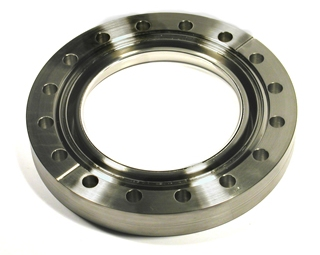
It is vital for the procedure in-situ to be observed in mary high vacuum and ultra-high vacuum (HV/UHV) Processes. The Challenge is that any optical component must Penetrate the hermetically sealed chamber but not compromise the quality of the vacuum. Engineering has been Undertaken to Create Specialized Flanged Windows and Viewports, Which Will then Allow the Observation of Vacuum Processes Directly or with the Assistance of an Internal Mirror Array.
When done in this way, there is no risk of the loss of press. The Quality of Materials used in the Flange and Gasket Largely Determines This Mechanical Performance.
Reliable Stainless Steel Alloys Such as Type 304 Typically Make Up Viewport Flanges, While High-Purity Copper (Cu) is considered to be the ideal Gasket Material in UHV Conditions. However, there is a wide ranges of Materials that are available for creating the transparent pane, which Ranges from Synthetic Sapphire Down to Standard Borosilicate Glass.
This article Details in What Circumstances and Why A Sapphire Viewport Might be used in HV/UHV Applications.
Outline Sapphire Viewports
in Engineering Applications, Sapphire is one of the Hardest Optical Materials Utilized. A Transparent, Single-Crystal Aluminum Oxide (AL2O3), Sapphire Additionally has superior thermomechanical properies as compared to almot Every other window Material that is used in HV/UHV Processing.
Compressive Strength of Approximately 2000 Megapascal (MPA) and A Flexural Strength Upwards of 400 MPA Are the Typical Mechanical Properties of Sapphire. Sapphire ViewPoints are notorious Hard and exploit the Material's Excellent Young's Modulus (~ 350 GPA), Which Helps to make sure that pane's stress-starin ratio is ideal for operation at pressures on an order of trillionths of the atmosphere.
o Undertake High-Temputure Vacuum Processing Applications, Sapphire Viewports Are also Followed. Such Applications Might Included Physical Vapor Deposition (PVD). It has been demonstrate that pane can connect withstand continuous operating temperatures in the region of 400 ° C (752 ° C), Although this limit is a restraint of the chamber architecture. Sapphire Alone can endure temperatures of up to 1800 ° C (3272 ° F).
Despite this, there are myriad alternative viewport materials that can operate in applications that are similarly pressurized and related to thermal processing. Sapphire's Primary Advantage Over Other Window Types is the excellent optical transmissivity that the material possesses.
To Wavelengths of Light Between 150—5500 Nanometers (NM), Sapphire Viewports Are Highly Transparent, Spanning A Great Deal of the Ultraviolet (UV) and Visible Spectrum With Excension Into The Near-Infrared (IR) Range. Optimal Viewing of HV/UHV Processing Conditions is ENSURED, Without Necessitating Additional Surface Coatings.
Sapphire's unparalleled mechanical properies are a key contributor towards this excellent quality of transmissivity, given that wavelength transmission can be significantly affected by poor surface finish, Particularly for short-wave.
Sapphire is the third hardest engineering material that exists on our planet, which guarants Incredible resistance to scratching and abrasion. Sapphire Viewports can retain their as-installed transmission properies for long-service in rugged processing surroundings as a result of this hardness.
